Thank goodness we’re into September, with the changing of the seasons (it’s snowing out my window as I type). August may be my least favorite month in southwest Colorado, because the wildflowers wither, the blue sky turns brown with wildfire smoke, and this year, out-of-state tourists filled virtually every parking spot in town and at trailheads. I cocooned close to home in August, missing my now-adult kids who moved away after months of coronavirus-induced family time.
Coaching my clients proved to be a bright spot during that otherwise dull month. Whenever I need a boost, I look at their training plans, study their workout data and read the comments they input after workouts. Their plans and feedback motivate me to get moving and do more myself.
For this reason, I’ve decided to spotlight a few of my clients because I’m impressed by how they make time to improve themselves through running and pursuing athletic goals in the midst of real-life demands on their time and energy.
My clients are not hard-core or elite. They are delightfully ordinary, mostly middle age, but they’ve devoted themselves to pursuing athletic goals, and becoming happier and healthier, because of the physical and psychological benefits that come with running. And this year, they’re doing it even though most of their goal races were cancelled. Like the old saying about travel, “it’s about the journey, not the destination,” they realize that consistent high-quality training, week after week, is in many ways more rewarding than meeting a time goal in a single race.
Whenever I write their training plans (using the TrainingPeaks platform) and correspond with them through text, email or video call, I invariably feel pumped up to develop and stick to my own training plan. I sometimes challenge myself to complete a particularly challenging workout that I wrote for one of them, thinking of Eleanor Roosevelt’s line, “It is not fair to ask of others what you are not willing to do yourself.”
So, enough about me … let me introduce you to some of my awesome clients who agreed to go public, so that they may motivate you, too. (And if you are interested in coaching services, you can find out more on this page and contact me.)
Avantika
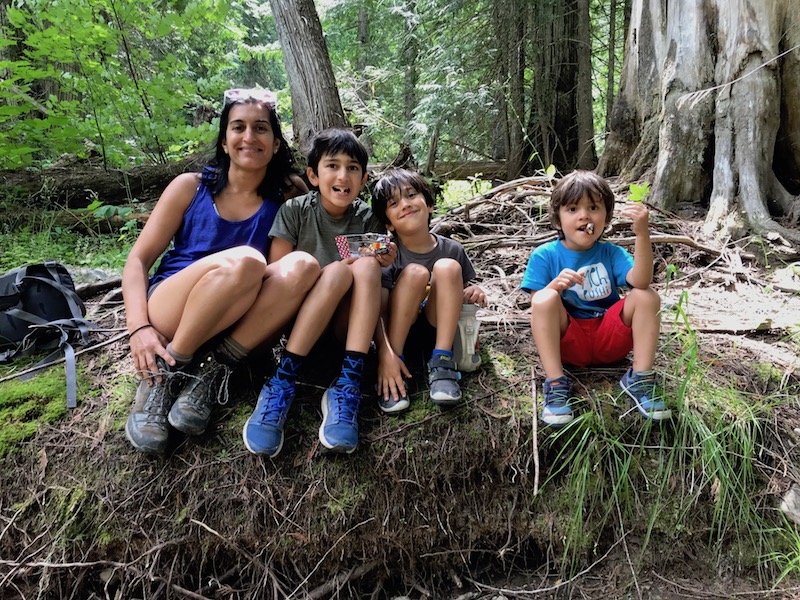
Avantika and her boys.
Avantika Waring contacted me toward the end of 2019 wanting to get her marathon time under 4 hours and finish her first 50K. She’s 40 and lives in Seattle. But she felt limited both by circumstances and by injury. She is super busy parenting three boys (ages 10, 7 and 4) and working full time as an endocrinologist. When her weekly mileage hit the mid-30s, she tended to get injured, and a physical therapist told her not to run more than four times a week.
When we started coaching, my advice was counter to what she heard from her PT. I advised her to run more frequently—five times a week, with some conditioning and cross-training layered in around her runs—and to structure her runs and workouts much differently. I get a lot of new clients who say they only run three or four times a week, and they don’t or “can’t” do speed work, because they’re worried about re-injury. To which I say, adapting your body to running more frequently helps injury prevention, and speed work is essential for cardio fitness and good running form! Let’s say you’re only running 20 miles a week. It’s better to spread those miles over five short runs during the week, and have one of those runs be higher intensity, instead of only running three or four times a week at the same slow pace. Consistency and frequency cause the body to better adapt to the stress of training.
Avantika now typically runs slightly more than 40 miles a week, five times a week, plus does strength work and some cross-training such as indoor cycling. She has lowered her pace for shorter intervals from the mid-7s to sub-7, and has grown the duration of her long runs to the 3 to 4+ hour range.
“For the first time I’ve been able to increase my weekly running volume without injury (fingers crossed),” she says. “In the past, every time I hit 35 miles per week, I’d get hurt. I’ve been consistently running more than this for months and feeling overall really great! I like the variety and direction to my daily runs. My body feels stronger and more resilient—for example, after my longest runs I’m still able to go out for a bike ride with my kids or walk around the neighborhood. In the past, after my long runs, I’d basically be out of commission the rest of the day.”
Her favorite and most challenging workouts? “I really enjoy the speed workouts. I like the ladder workouts that incorporate different distances of intervals. I also enjoy the short strength routines that are added to the end of a run—it’s a great way to cool down from the cardio and really fatigue the muscles after a hard run. … I still find the longest runs assigned to be the hardest to do. My 4+ hour trail run was really challenging to get motivated for—I had a hard time getting out the door, but once I was out there, it was terrific, and the accomplishment of having finished it was immense.”
How does she find the time? “The silver lining of the pandemic has been that our work and school schedules have started later, so I have been able to do my morning runs at a slightly later time and gotten more sleep! That has felt really healthy. I still struggle to run any time of day besides the morning, however. If I don’t get it done before work, something always tries to get in the way. I force myself to get up and run before anyone else wakes up, so that I don’t have to feel any mom-guilt about not helping with the morning routine, or missing out on family time in the evenings.”
Good luck to Avantika as she tackles a solo self-supported 50K—her first ultra—in about three weeks!
Brad
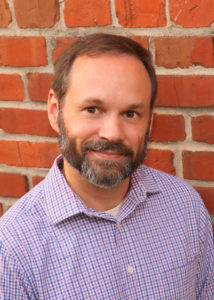
Brad
Brad Mitchell, who’s 45 and lives in North Carolina, contacted me in June wanting to become an ultrarunner again. He has one 100-miler under his belt, from 2014, but this year he lapsed into running only about 3 miles a couple of times a week.
Brad’s biggest challenges to regularly running longer distances have been his schedule and North Carolina’s intensely humid climate. He works more than 55 hours a week for a lending company, plus he’s an ordained minister who leads a congregation every Sunday. He also committed to teaching spin classes at his local Y on Fridays and Saturdays, which complicates his weekend long-run plan.
“Coaching has motivated me to get out the door on a regular basis and work towards a goal each workout,” Brad says. “All workouts are purposeful. They push me to do things I would not otherwise attempt. I’m a fairly slow runner, so speed intervals have always been avoided. Coaching has given me the courage to try harder and really work on my speed.”
We started with a schedule that included only 4 runs a week, with one speed session on Tuesdays, plus a couple of conditioning workouts. We de-emphasized the long run (his “long” runs started out only in the 60 to 90 minute range) and emphasized getting in a pattern of higher-quality weekday runs. Three months later, he’s consistently running 5 times a week, doing strength work twice a week on top of teaching the indoor cycling classes, and completing long runs in the mid-teens or about 2.5 hours.
“I basically have no time if I look at my schedule,” he says. “My normal day can easily eat up any time for myself. To combat this, I get up before everyone else and get the run completed. … If I do not get up and do the workouts early in the morning, the chances of completion are almost zero. I know it’s important for me, so I make sure to plan it out each morning.”
His favorite workout? “For the speed interval, I enjoyed the ‘pick your poison’ workout. It gave me the freedom to choose yet pushed me to get the speed workout done within parameters. It was good to think through my options and pick what I wanted to do.”
(Here’s a screen shot from Brad’s TrainingPeaks that shows my description of the workout. Brad ended up choosing 3 x 6 min.)
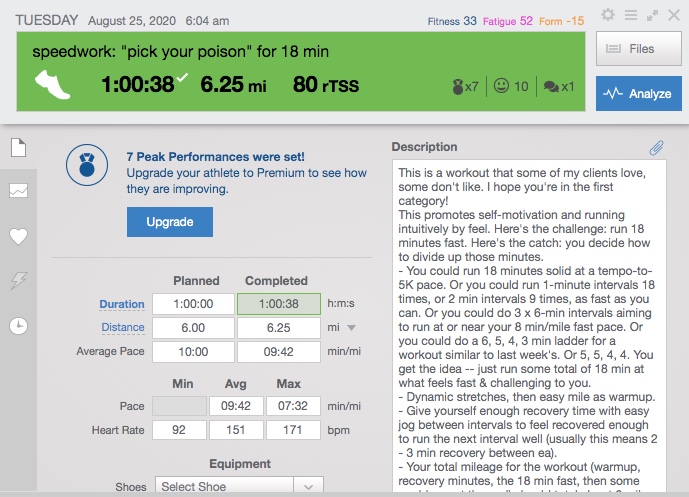
Brad’s main goal is to finish a 100-miler in 2021 under 24 hours. I believe he can do it!
George
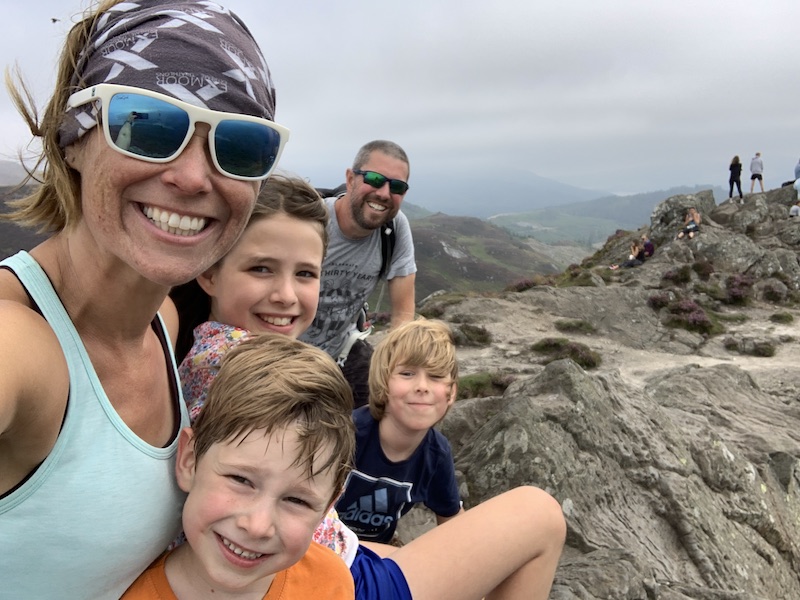
George in the UK
Georgina Everett, who goes by George, is 44 and lives in southwest London. She’s a mother of three and also works as a personal trainer. She hired me in February to train for several ultras this year, most notably a 100K in England in July, and the Grand to Grand Ultra self-supported race in September. Alas, all her races were cancelled, but she kept training diligently anyway.
I find her coaching notes both inspiring and entertaining because of the creative ways she finds to complete her workouts—not always following the plan precisely, but doing the best she can under the circumstances. During the UK’s pandemic lockdown, she and her family were supposed to restrict their recreation to one outdoor activity per day. George divided her long runs into segments that were out-and-backs from her home so that one child could ride his or her bike alongside as she ran, thus giving each child one-on-one time outside with their mother. We also ended up developing a lot of creative treadmill workouts so she could run more indoors and not lose her mind with boredom on the treadmill.
George says our coaching “has made me think about the quality of what I do. I was coached previously for triathlon and up to marathon distance, which I found invaluable, but as I moved to ultrarunning and multi-day runs, I self-coached … but with this I added junk miles rather than specificity. I didn’t have the knowledge in this area, and with the time pressures of work and family, I simply ran.”
We added specific workouts and goals to help George improve speed and fine-tune her sense of pacing; to alternate easy and hard days; and to improve her mid-race “systems management” of fueling, hydration, thermoregulation and general trouble-shooting.
One week this summer, to give her a different challenge and to boost her mileage total to 70, I assigned her to run the same 10-mile loop every day. But, she had specific pace and time goals for each of the runs; e.g., one day she had to run it extra-easy to cultivate patience, another day she had to run a negative split (second half faster), another day she had to run at an unusual time of day (like at sunset instead of morning), and on the final day she had to run it as fast as possible.
Her favorite workout? “Boot camp run. It makes a treadmill run so much more interesting.” This is a workout that involves a cardio/strength warmup (such as a combo of mountain climbers and pushups), then a treadmill run of about 7 miles. Each mile is run at a specific pace and incline. Plus, she has to pause the treadmill every mile and hop off for a set of exercises, such as box jumps or burpees.
George’s first ultra of the year—canceled in April, then rescheduled for September—is two weekends from now in England, a 62K (38.5 miles). “It will be my second longest run at once ever, and my 4th ultra, and I’m excited!”
Heather
I met Heather Sackett, who’s 38, a few summers ago, and we ran together around Telluride. Then she moved to Carbondale to work as an environmental reporter specializing in Colorado water issues. She hired me early this year to see what she could accomplish as a runner through focused training.
“I’ve done a couple of 50-mile races, and I usually ended up limping across the finish line because I was under-trained. I felt like I barely survived, never like I crushed it. So I really wanted to finish a race strong and feel like I gave it everything I had,” she says. “I can tell I’m making progress toward that goal because I have slowly but surely started feeling stronger after long runs. When I first started training back in March, a 13-mile run would destroy me, and I would spend the rest of the day on the couch. Now, I feel like I can easily handle a higher volume of running, I’m not destroyed by longer runs and I recover faster.”
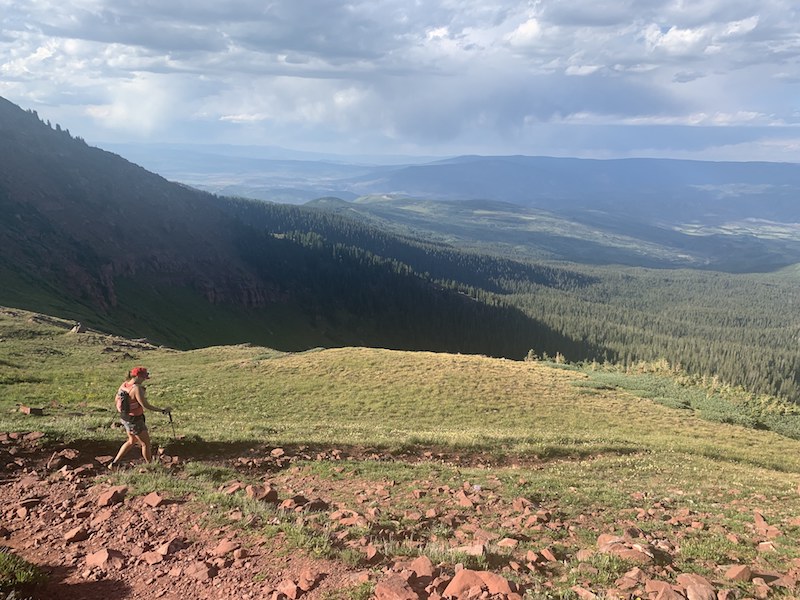
Heather on a long training run.
Heather’s months-long training paid off last weekend when she met her goals in her first and only ultra of the year, the Grand Traverse in Crested Butte. The race is normally 40 miles long, but this year’s re-routed course was longer and unknown. Competitors were expecting it to be around 43, but they discovered it was around 47 total.
“I finished strong and met my time goal even though I was thrown for a loop when the race ended up being 3 to 4 miles longer than advertised. Because I had put in the training and long days in the mountains, I was able to troubleshoot on the fly and not get totally demoralized when I was faced with surprise additional miles.” Heather finished solidly mid-pack and with a faster average pace than we had estimated, because she was able to run so much of the course rather than succumb to extended hiking breaks on runnable stretches.
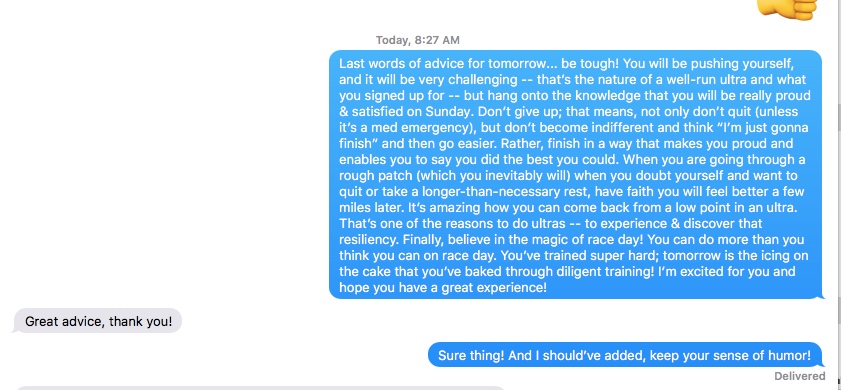
A text exchange we had the day before her ultra.
Looking back, Heather credits speed work for her improvement. Her speed sessions ranged from short intervals with specific pace guidance, to a virtual 5K. “I’ve found that I actually like speed workouts, which was a total surprise. I was dreading them at the beginning of my training, but looking forward to them by the end. Fast running always just seemed to hurt and was a mental challenge too. But with consistent training, I saw my times start to improve and I felt better too, which gave me a sense of accomplishment. … Since most all races were cancelled this year, the speed workouts were really the only concrete benchmark I could use to see myself improve each week.”
She also says the training plans “did wonders for my sanity … especially in COVID times when there’s so much uncertainty and anxiety, the daily workout schedule kept me grounded and focused on something besides doom-scrolling through the news. I also think the consistency that coaching provides is a key to improving. Just the fact that I had a training plan schedule to tell me what to do every day was enough to hold me accountable and not skip runs or slack off.”
Dave
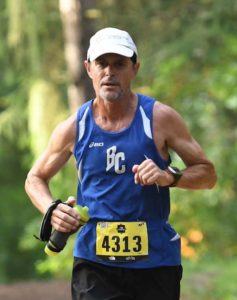
Dave Witko
Dave Witko is 62 and divides his time between Arizona and Wisconsin. He hired me last December with the goal of performing well in his age division at the Miwok 100K in May, which got cancelled, but Dave achieved significant progress leading up to it.
“Being retired, I have no issues finding time to train. My issue was/is just the opposite: how to avoid just piling on junk miles and instead do higher-quality workouts,” Dave says. “Not to make this sound like a sales pitch for Sarah, but she really took a holistic approach to my coaching and gave just the right mix of structure, flexibility, total body conditioning and sage advice. Geez, we even did ‘toe yoga’!”
One thing I do as a coach is find and assign online workouts that I recommend, particularly for conditioning, that other coaches have produced and put online, so that my clients have a visual aid since I’m not there to guide them in person. Some of my favorites include Jay Johnson’s Lunge Matrix for warming up, or some of the short Yoga by Adriene or Yoga by Kassandra videos for cooldown or for recovery after a depleting run. When I assigned Dave the Bronco Billy’s Tough 21 Strength Routine by Jeff Browning, that really clicked for him and became a favorite go-to conditioning workout.
Dave’s other favorite workout? Speed sessions with intervals of varying distances that follow a pattern of climbing, peaking or descending; i.e., a ladder. “I never thought I could do ‘ladder intervals’ other than just going through the motions. But reporting back to my coach that I did a decent job became very important to me and was good motivation to invest the necessary effort,” he says. “OK, I ‘may’ have skipped a rung here or there, but I actually grew to enjoy doing ladder intervals.”
Fingers crossed we’ll be back to regular racing in 2021 so Dave can go for his goals at the Black Canyon and Miwok 100Ks.
Erica
I coached Erica Garrett in 2018 to prepare for a 50K, and then she went on hiatus to have her first baby. She’s now 33, living in Denver and working as a heath care consultant while raising her daughter. She restarted coaching this year to get back in shape and rekindle her long-term goal of successfully completing a 50-miler.
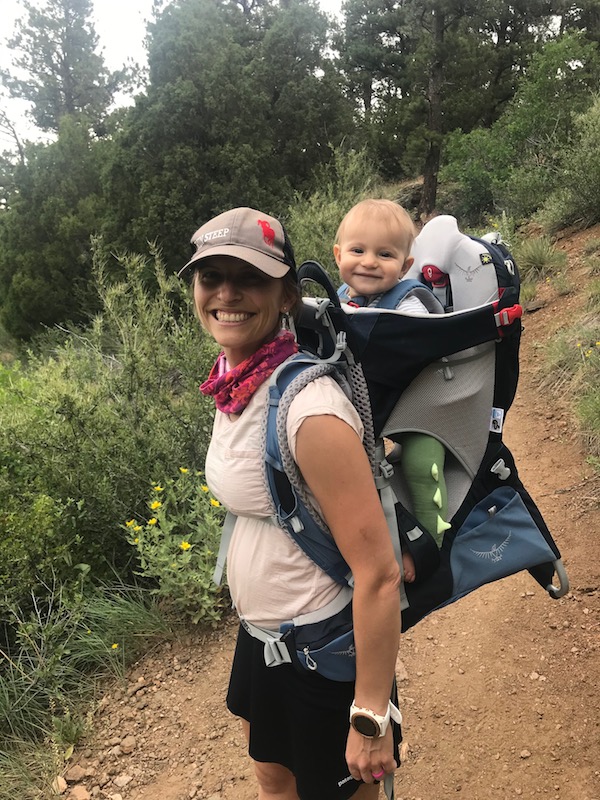
Erica
A couple of weekends ago, Erica entered her first trail race of the year— a 25K (15.5 miles)—and ran strong, meeting her time goal. “Five months ago, I was barely running 4 miles at a 10-minute pace,” she says. Now she can run a 5K at a sub-8 pace and a mile in 7 flat.
This past season of training “helped me build up mileage and speed safely and avoid injury, and also brought some normalcy to my life during these crazy times. There are so many days when I feel like I’m not doing great at work, or I’m not doing great at parenting, but most of the time I at least feel like running is something I can do!”
To get her training in, Erica wakes up early to run solo on her hard-run days, or runs with her daughter in a stroller on easy-run days. “I would bring my daughter to the park and set her up with some toys on a picnic blanket while I did my strength workouts,” she says. One of her favorite workouts is a combo of running and strength work, stopping at intervals mid-run to do prescribed exercises. Her most challenging workout? “Probably the mile time trial or 5K time trial,” she says.
Erica is getting ready for a 50K in Utah in late November, and then we’ll plan for a 50M in 2021.
Colette
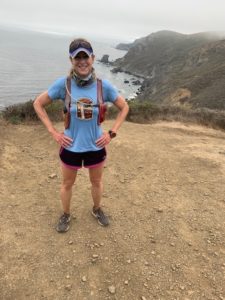
Colette
When Colette Plum contacted me, I knew I wanted to coach her because I really relate to her. We’re similar in age (she’s 53), she has two kids close in age to mine, and she lives in the East Bay Area, near where I lived for some 25 years. When I develop her plans, I love being able to design very specific workouts on favorite trails I used to run in the East Bay Regional Park District.
Colette says she sought a coach not only to improve as a runner, but to help cope with stress. She works full time as deputy director for the study abroad program at UC Berkeley, and the pandemic torpedoed the program in the spring, leaving her scrambling to bring students back to the U.S. and make alternate plans for them. On top of her job stress, her dad died suddenly in April, and her daughters needed extra attention to handle remote schooling. “I tried to be there for everyone else, and I was sacrificing running to make everything else work,” she says. “My husband encouraged me to find a coach, an ally to really help support me as I set running goals for myself. … Before I found a coach, if I didn’t have a race on my calendar, I would run just enough to barely maintain fitness, but not really develop further or challenge myself.”
With coaching, she says, she runs nearly every day, and “running is central to my well-being rather than an add-on. … I’m feeling great about my aging body, seeing improvements in both fitness and form, feeling energetic and youthful.”
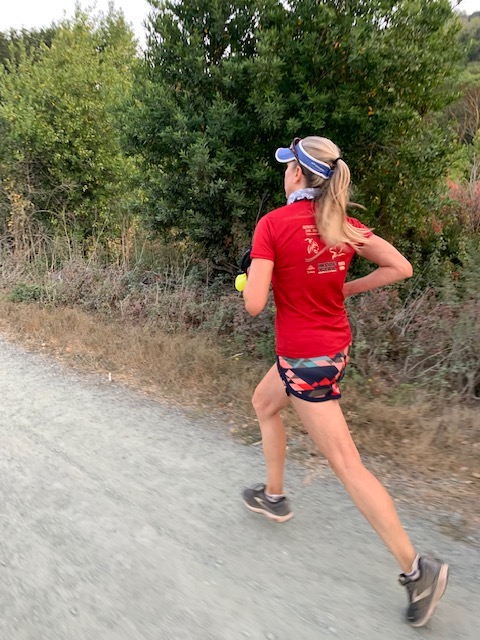 What’s a favorite challenging workout that sticks in her mind? She points to a hard weekday run from a couple of weeks ago, during peak training. She was assigned a 2 hour run, totaling about 11 miles, on a hilly route. “My job was to go easy the first hour, then kick it in during the second hour for 30 minutes at half-marathon pace, then follow this with 3 x 3-minute on-offs at 90-95% effort after those first 90 minutes. I loved the range of mental focus needed for this run. I got to go ‘easy’ for an hour—but when is a hilly route ever ‘easy’ for the entire 60 minutes? Then I had to apply one kind of sustained focus for half-marathon pace on hills, then a different kind of focus for the all-out effort at the end. So. Much. Fun. Really. I felt so proud of myself when I was done, and also aware that my ability to do the workout was the culmination of thoughtful and well-planned training that got me through to my week of race-specific peak training.”
What’s a favorite challenging workout that sticks in her mind? She points to a hard weekday run from a couple of weeks ago, during peak training. She was assigned a 2 hour run, totaling about 11 miles, on a hilly route. “My job was to go easy the first hour, then kick it in during the second hour for 30 minutes at half-marathon pace, then follow this with 3 x 3-minute on-offs at 90-95% effort after those first 90 minutes. I loved the range of mental focus needed for this run. I got to go ‘easy’ for an hour—but when is a hilly route ever ‘easy’ for the entire 60 minutes? Then I had to apply one kind of sustained focus for half-marathon pace on hills, then a different kind of focus for the all-out effort at the end. So. Much. Fun. Really. I felt so proud of myself when I was done, and also aware that my ability to do the workout was the culmination of thoughtful and well-planned training that got me through to my week of race-specific peak training.”
Colette is now tapering for a solo self-supported 50K next weekend, which is a stepping stone to a 50-miler she plans to run in late November. She’s also suffering through the poor air quality and ominous orange sky plaguing Northern California. She credits running and coaching to helping her become “not just race ready, but pandemic ready. … Most ultrarunners know that the lessons we learn on the trail are really lessons for our lives, and this seems all the more important to me when I’m challenged with working my job and caring for others during a pandemic. I don’t really know what any given day will bring, but I have the confidence that patience, grit, being in the moment with each step and stride, self-care and self-compassion, and a good dose of wonder will get me through it. ‘It’s a gift to be here!’ is something I want to be able to say on any trail and in any hour.”
Endnote
I recently updated the “Bookshelf” column on the side of my blog with links to books I’ve read and enjoyed, in case you’re looking for reading recommendations. And if you would like a personalized, signed copy of my book The Trail Runner’s Companion for yourself or as a gift, message me and I can sign & send one directly to you.

Loved this post. So interesting.